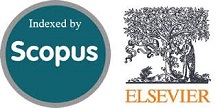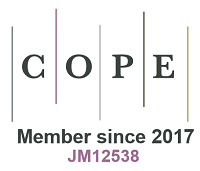Optimizing Mortar Mixtures with Basalt Rubble: Impacts on Compressive Strength and Chloride Penetration
DOI:
https://doi.org/10.28991/CEJ-2024-010-12-013Keywords:
Basalt Rubble, Construction Materials, Chloride Penetration, Strength.Abstract
This research aims to establish a theoretical framework for developing binders from waste materials to reduce cement use in mortar production. It specifically examines the potential of ground basalt rubble (BS) as a supplementary binding material for partially replacing Portland cement Type 1 (OPC) in mortar mixtures. Various substitution ratios of BS, specifically 0%, 10%, 20%, 30%, and 40% by binder weight, were tested while maintaining a constant water-to-binder ratio (W/B) of 0.45. Superplasticizers (SP) were utilized to ensure consistent workability and flow of the mixtures. The SEM-EDS analysis was conducted to examine the microstructure of the cement paste, confirming the presence of calcium silicate hydrate (C-S-H) phases resulting from the pozzolanic reactions of BS. The findings showed that, at the 7-day test, replacing cement with 10% and 20% basalt rubble (BS) by weight of the binder yielded compressive strengths of 97% and 92% compared to the control (CT) mortar. In contrast, replacements of 30% and 40% BS resulted in compressive strengths of 72% and 60% of the CT mortar, respectively. Results from 28-day tests showed that replacing 10% of OPC with BS not only increased the compressive strength but also significantly decreased chloride penetration compared to the control mortar (CT). This enhancement suggests that BS can effectively replace 10%-20% of cement, with the compressive strength of the mortar ranging from 92% to 107% of that of the control. The findings accentuate the potential of using industrial by-products such as ground basalt rubble to reduce waste, alleviate environmental impacts, and promote the development of sustainable construction materials.
Doi: 10.28991/CEJ-2024-010-12-013
Full Text: PDF
References
[2] Rukzon, S., & Chindaprasirt, P. (2018). Strength, chloride penetration and corrosion resistance of ternary blends of portland cement self-compacting concrete containing bagasse ash and rice husk-bark ash. Chiang Mai Journal of Science, 45(4), 1863–1874.
[3] Fu, H., Pang, B., Wang, P., Yang, C., Liu, Y., Du, Z., & Ji, H. (2024). Microstructure and durability of rapid repair mortar with self-emulsifying waterborne epoxy polymer. Materials Today Communications, 40, 109375. doi:10.1016/j.mtcomm.2024.109375.
[4] Chindaprasirt, P., Chotetanorm, C., & Rukzon, S. (2011). Use of Palm Oil Fuel Ash to Improve Chloride and Corrosion Resistance of High-Strength and High-Workability Concrete. Journal of Materials in Civil Engineering, 23(4), 499–503. doi:10.1061/(asce)mt.1943-5533.0000187.
[5] Rukzon, S., & Chindaprasirt, P. (2013). Strength, porosity, and chloride resistance of mortar using the combination of two kinds of pozzolanic materials. International Journal of Minerals, Metallurgy and Materials, 20(8), 808–814. doi:10.1007/s12613-013-0800-x.
[6] El-Didamony, H., Helmy, I. M., Osman, R. M., & Habboud, A. M. (2015). Basalt as Pozzolana and filler in ordinary Portland cement. American Journal of Engineering and Applied Sciences, 8(2), 263–274. doi:10.3844/ajeassp.2015.263.274.
[7] Day, K. W. (2021). Properties of concrete. In Concrete Mix Design, Quality Control and Specification. Longman Group Limited, Malaysia. doi:10.4324/9780203967874-11.
[8] Pereira, V. M., Geraldo, R. H., Baldusco, R., & Camarini, G. (2022). Porcelain waste from electrical insulators in self-leveling mortar: Materials characterization and properties. Journal of Building Engineering, 61. doi:10.1016/j.jobe.2022.105297.
[9] Becerra-Duitama, J. A., & Rojas-Avellaneda, D. (2022). Pozzolans: A review. Engineering and Applied Science Research, 49(4), 495-504.
[10] Saudi, H. A., Maha, F. A. A., Ahmaed, M. M., & Algendy, A. A. (2024). A Framework for Studying the Possibility of Using Basalt Cement as a Cladding Material for Indoor Spaces. Information Sciences Letters, 13(2), 377–386. doi:10.18576/isl/130215.
[11] Rashad, A. M., Mohamed, R. A. E., Zeedan, S. R., & El-Gamal, A. A. (2024). Basalt powder as a promising candidate material for improving the properties of fly ash geopolymer cement. Construction and Building Materials, 435, 136805. doi:10.1016/j.conbuildmat.2024.136805.
[12] Abo Hashem, I. A., Gaber, G. A., Ahmed, A. S. I., & Abdel Ghany, N. A. (2024). Assessment of blended cement containing waste basalt powder: physicomechanical and electrochemical impedance spectroscopy investigations. Discover Applied Sciences, 6(8), 380. doi:10.1007/s42452-024-06075-x.
[13] Çelikten, S., & Baran, B. (2024). A comprehensive assessment of mechanical and environmental properties of waste basalt powder-modified high strength mortars exposed to high temperature. Next Materials, 5, 100273. doi:10.1016/j.nxmate.2024.100273.
[14] Ye, F., Feng, Q., Qiao, H., Zhu, X., Su, L., Xue, C., Cao, H., & Zhang, L. (2024). Study on multi-objective matching ratio optimization and strength development law of basalt stone powder composite cementitious materials. Construction and Building Materials, 417, 135088. doi:10.1016/j.conbuildmat.2024.135088.
[15] ASTM C204-18e1. (2023). Test Method for Fineness of Portland Cement by Air Permeability Apparatus. ASTM International, Pennsylvania, United States. doi:10.1520/C0204-18E01.
[16] ASTM C618-00. (2017). Standard Specification for Coal Fly Ash and Raw or Calcined Natural Pozzolan for Use as a Mineral Admixture in Concrete. ASTM International, Pennsylvania, United States. doi:10.1520/C0618-00.
[17] ASTM C230/C230M-20. (2021). Standard Specification for Flow Table for Use in Tests of Hydraulic Cement. ASTM International, Pennsylvania, United States. doi:10.1520/C0230_C0230M-20.
[18] ASTM C109/C109M-20. (2020). Standard Test Method for Compressive Strength of Hydraulic Cement Mortars (Using 2-in. or [50-mm] Cube Specimens). ASTM International, Pennsylvania, United States. doi:10.1520/C0109_C0109M-20.
[19] Otsuki, N., Nagataki, S., & Nakashita, K. (1993). Evaluation of the AgNO3 solution spray method for measurement of chloride penetration into hardened cementitious matrix materials. Construction and Building Materials, 7(4), 195–201. doi:10.1016/0950-0618(93)90002-T.
[20] Tang, L., & Nilsson, L. O. (1995). A discussion of the paper "calculation of chloride diffusivity in concrete from migration experiments, in non-steady-state conditions” by C. Andrade, D. Cervigón, A. Recuero and O. Río. Cement and Concrete Research, 25(5), 1133–1137. doi:10.1016/0008-8846(95)94178-U.
[21] Chindaprasirt, P., & Rukzon, S. (2015). Strength and chloride resistance of the blended Portland cement mortar containing rice husk ash and ground river sand. Materials and Structures/Materiaux et Constructions, 48(11), 3771–3777. doi:10.1617/s11527-014-0438-9.
[22] Pachideh, G., Gholhaki, M., & Ketabdari, H. (2020). Effect of pozzolanic wastes on mechanical properties, durability and microstructure of the cementitious mortars. Journal of Building Engineering, 29, 101178. doi:10.1016/j.jobe.2020.101178.
[23] Pekmezci, B. Y., & Akyüz, S. (2004). Optimum usage of a natural pozzolan for the maximum compressive strength of concrete. Cement and Concrete Research, 34(12), 2175–2179. doi:10.1016/j.cemconres.2004.02.008.
[24] Moawad, M. S. M., Ragab, A. E.-R., & Younis, S. (2023). Effect of the Natural Pozzolanic Basalt on High Strength Concrete. Mansoura Engineering Journal, 48(2), 1 16. doi:10.58491/2735-4202.3063.
[25] Yu, L., Zhou, S., & Dong, J. (2020). Investigation into Pozzolanic Activity Component of Basalt and Pumice. Journal of Materials in Civil Engineering, 32(6), 4020135. doi:10.1061/(asce)mt.1943-5533.0003180.
[26] Moawad, M. S., Younis, S., & Ragab, A. E. R. (2021). Assessment of the optimal level of basalt pozzolana blended cement replacement against concrete performance. Journal of Engineering and Applied Science, 68(1). doi:10.1186/s44147-021-00046-4.
[27] El-Desoky, H. M., El-Shafey, R. E., & Omar, A. A. (2024). Effect of partially replacement of ordinary Portland clinker by basaltic rocks on the properties of blended cement. HBRC Journal, 20(1), 55–70. doi:10.1080/16874048.2023.2298765.
[28] Khan, K., Amin, M. N., Saleem, M. U., Qureshi, H. J., Al-Faiad, M. A., & Qadir, M. G. (2019). Effect of fineness of basaltic volcanic ash on pozzolanic reactivity, ASR expansion and drying shrinkage of blended cement mortars. Materials, 12(16), 2603. doi:10.3390/ma12162603.
[29] Ponzi, G. G. D., Santos, V. H. J. M. dos, Martel, R. B., Pontin, D., Stepanha, A. S. de G. e., Schütz, M. K., Menezes, S. C., Einloft, S. M. O., & Vecchia, F. D. (2021). Basalt powder as a supplementary cementitious material in cement paste for CCS wells: chemical and mechanical resistance of cement formulations for CO2 geological storage sites. International Journal of Greenhouse Gas Control, 109, 103337. doi:10.1016/j.ijggc.2021.103337.
[30] Chand, G. (2021). Microstructural study of sustainable cements produced from industrial by-products, natural minerals and agricultural wastes: A critical review on engineering properties. Cleaner Engineering and Technology, 4, 100224. doi:10.1016/j.clet.2021.100224.
Downloads
Published
Issue
Section
License
- authors retain all copyrights - authors will not be forced to sign any copyright transfer agreements
- permission of re-useThis work (including HTML and PDF Files) is licensed under a Creative Commons Attribution 4.0 International License.







